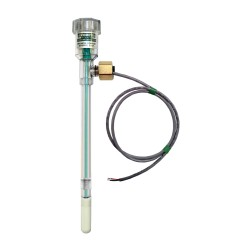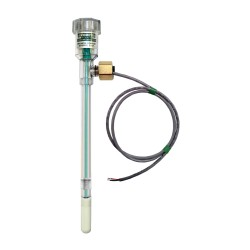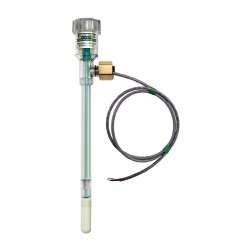
Irrometer SR Short Range Tensiometer
Professional short-range tensiometer for measuring soil water tension in shallow root zones. Ideal for vegetables, flowers, and turfgrass irrigation management.
Product Highlights
View all in Specifications tabOverview
The Irrometer SR (Short Range) is a professional-grade tensiometer designed for monitoring soil water tension in shallow root zones. Perfect for vegetables, flowers, containerized plants, and turfgrass, the SR model provides accurate, real-time measurements of plant-available water in the critical upper soil profile where most roots actively absorb moisture.
Key Features
- Direct Measurement: Measures actual soil water tension, not inferred values
- Fast Response: Rapid equilibration with soil moisture changes
- Shallow Monitoring: Optimized for 6-12 inch (15-30 cm) depths
- Easy Reading: Clear vacuum gauge with centibar scale
- Proven Technology: Time-tested design used worldwide since 1951
- No Calibration: Works in all soil types without calibration
- Visual Indication: Quick visual check of soil moisture status
- Professional Grade: Durable construction for long-term use
Applications
- Vegetable crop irrigation
- Flower and ornamental production
- Greenhouse growing systems
- Container plant management
- Turfgrass and sports fields
- Landscape irrigation
- Nursery production
- Berry crops
- Shallow-rooted field crops
- Precision irrigation scheduling
Technical Specifications
The Irrometer SR tensiometer uses a water-filled tube with a porous ceramic cup at the bottom. When installed in soil, water moves through the ceramic cup in response to soil moisture levels, creating a vacuum measured by the gauge. The reading directly indicates how hard plants must work to extract water from the soil.
Understanding Tensiometer Readings
Tensiometer readings in centibars indicate soil moisture status:
Irrigation Zones
- 0-10 cb: Saturated, excess water present
- 10-25 cb: Field capacity, ideal moisture for most crops
- 25-40 cb: Good moisture, slight stress in sensitive crops
- 40-60 cb: Moderate stress, irrigation recommended
- 60-70 cb: High stress, irrigate immediately
- 70-80 cb: Severe stress, near instrument limit
When Gauge Reads 80 cb
When the gauge reaches approximately 80 centibars, the vacuum inside the tensiometer reaches the limit where air can enter through the ceramic cup, causing the instrument to “break tension” and lose vacuum. This indicates very dry soil conditions and immediate irrigation need.
Installation Guidelines
Selecting Installation Depth
The SR model is designed for shallow installations:
- Shallow vegetables: 15 cm (6 inches)
- Most vegetables: 20-25 cm (8-10 inches)
- Turfgrass: 15-20 cm (6-8 inches)
- Flowers and ornamentals: 15-25 cm (6-10 inches)
Installation Procedure
- Create pilot hole: Use soil auger or installation tool
- Mix slurry: Create mud slurry from native soil and water
- Fill hole: Pour slurry into auger hole
- Insert tensiometer: Push firmly into slurry to specified depth
- Fill with water: Remove cap and fill tube with clean water
- Eliminate air bubbles: Tap tube to release trapped air
- Replace cap: Tighten cap securely
- Wait for equilibration: Allow 24-48 hours before first reading
Site Selection
- Install in representative areas of irrigation zone
- Place in active root zone of target crop
- Avoid anomalies (rocks, hardpan, low spots)
- Keep away from emitters and sprinkler heads
- Use multiple tensiometers for large or varied areas
- Mark locations clearly for easy finding
Reading and Maintenance
Taking Readings
- Visual check: Look at gauge from above
- Record value: Note the centibar reading
- Check frequency:
- Daily during active growth and hot weather
- Every 2-3 days during moderate conditions
- Before and after each irrigation
Irrigation Decision Making
Irrigation Trigger Points:
- Sensitive crops (lettuce, flowers): 30-40 cb
- Moderate crops (tomatoes, peppers): 40-50 cb
- Stress-tolerant crops: 50-60 cb
- Turfgrass (cool season): 40-50 cb
- Turfgrass (warm season): 50-60 cb
Maintenance Requirements
Weekly Maintenance:
- Check water level in tube (should be visible near top)
- Top off with clean water if needed
- Verify gauge is reading properly
Monthly Maintenance:
- Remove cap and add water if low
- Check for air bubbles (tap tube to release)
- Inspect for damage or leaks
Seasonal Maintenance:
- Clean ceramic cup if clogged (use household bleach solution)
- Replace water in tube
- Check gasket and cap seal
Refilling Procedure
- Remove cap
- Add clean water to near top of tube
- Tap tube to release air bubbles
- Replace cap securely
- Check gauge returns to reading within hours
Troubleshooting
Gauge Stays at Zero:
- Tensiometer may be in saturated soil (correct reading)
- Air leak in system (check cap seal, tube integrity)
- Need to refill with water
Gauge Stays at 80+ cb:
- Soil is very dry (correct reading - irrigate!)
- Tension broke, air entered cup (refill and wait for re-equilibration)
- Ceramic cup may be clogged (clean or replace)
Erratic Readings:
- Air bubbles in tube (tap to release, refill if needed)
- Poor soil contact (remove and reinstall)
- Damaged ceramic cup (replace)
No Response to Irrigation:
- Water not reaching tensiometer depth
- Irrigation amount insufficient
- Check distribution uniformity
Seasonal Management
Spring Installation
- Install after soil thaws and dries enough to work
- Allow full equilibration before relying on readings
- Start with fuller tube to last through season
Summer Operation
- Check and refill more frequently in hot weather
- Monitor closely during peak water demand
- Use multiple tensiometers for better coverage
Fall/Winter Storage
- Remove before freezing temperatures
- Clean ceramic cups
- Store with cups submerged in water
- Rinse tubes and caps
Advantages of Tensiometers
vs. Other Soil Moisture Sensors
- Direct measurement: Measures actual water tension plants experience
- Real-time response: Immediate response to irrigation and rainfall
- No calibration: Works in any soil type
- Simple technology: Easy to understand and maintain
- Visual feedback: Quick visual check of status
- Cost-effective: Low initial cost, long service life
Physical Principle
Tensiometers measure soil matric potential - the actual force plants must overcome to extract water. This is more directly related to plant water availability than volumetric water content measured by other sensors.
Combining with Other Depths
For complete root zone monitoring, use multiple tensiometer lengths:
- SR (6-12”): Shallow root activity and irrigation response
- MLT (18-24”): Middle root zone and water storage
- LT (36-48”): Deep roots and drainage monitoring
This multi-depth approach provides:
- Complete moisture profile
- Better irrigation timing
- Detection of over-watering (deep percolation)
- Confirmation of full profile wetting
- Drought stress early warning
Irrigation System Integration
Manual Irrigation
- Check readings before irrigation events
- Determine irrigation timing based on readings
- Verify sufficient water applied post-irrigation
- Adjust schedule based on crop response
Automated Systems
- Some tensiometers available with electronic sensors
- Can trigger automatic irrigation
- Integration with controllers and dataloggers
- Remote monitoring capabilities
Water Conservation
Proper use of tensiometers improves water efficiency:
- Prevent over-irrigation: Irrigate only when needed
- Optimize timing: Water when plants most benefit
- Reduce deep percolation: Avoid excess water below root zone
- Lower costs: Reduce water, pumping, and fertilizer expenses
- Environmental benefits: Minimize runoff and groundwater contamination
Professional Applications
The SR tensiometer is widely used by:
- Commercial vegetable growers
- Greenhouse operators
- Golf course superintendents
- Landscape professionals
- Nursery managers
- Agricultural researchers
- Irrigation consultants
- Water agencies
Research and Education
Tensiometers are valuable tools for:
- Irrigation research studies
- Teaching soil-plant-water relationships
- Demonstrating irrigation principles
- Calibrating irrigation schedules
- Validating other sensor types
- Water use efficiency studies
Quality and Reliability
Irrometer Company has manufactured tensiometers since 1951, establishing the standard for quality and reliability. Each instrument is:
- Made in the USA
- Quality controlled and tested
- Designed for field durability
- Supported by extensive documentation
- Backed by company expertise and support
Related Products
Other solutions in the soil category


